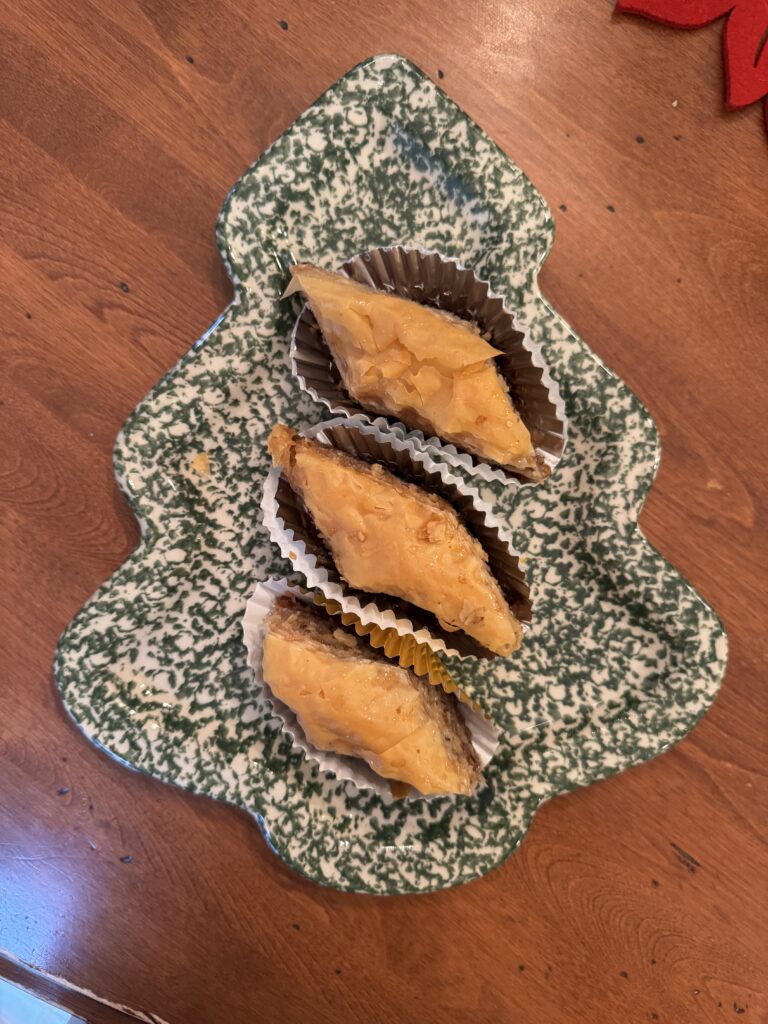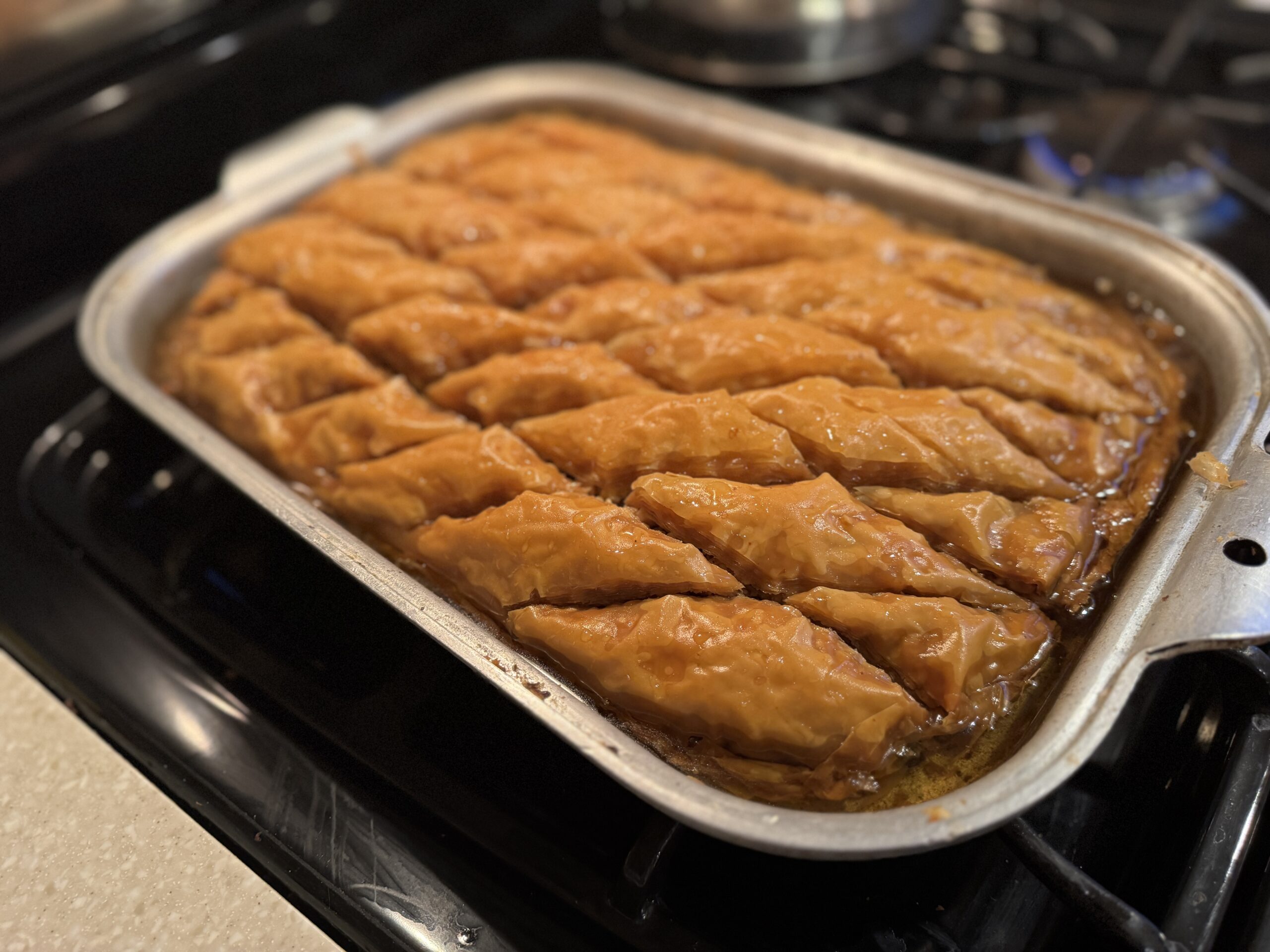If you were to ask me which Greek dessert reminds me the most of family and tradition I would have say without a doubt it’s Traditional Greek Baklava with Walnuts and Honey! One of my fondest memories of growing up in a Greek household is coming home and smelling the delicious aroma of phyllo, melted butter, cinnamon and honey wafting from the oven. Just one bite of baklava and you’ll know why it’s the best — the texture of crispy phyllo, combined with crunch cinnamon-flavored walnuts, and the sweet honey-flavored syrup combine into a burst of flavor with every decadent bite.

The best childhood memories!
As a child, I loved helping my Mom make Traditional Greek Baklava with Walnuts and Honey. There are quite a few steps in the recipe, and some are perfect for little helping hands! My Mom was always patient with me; carefully explaining each step of the process, answering my questions, and making me feel like her indispensable sous chef. I even had a miniature apron to wear just like hers!

Baklava for every happy occasion
The memories of making baklava with my Mom are intermingled with some of the most important events in our family history. Whether it was a baptism or baby shower, a wedding, Easter or Christmas, there was always a freshy baked baklava ready for all of us to enjoy and to commemorate the occasion.

Keeping Mom’s memory alive
Recently, as my co-workers and I were sharing our favorite holiday memories in a team icebreaker, I told the story of how much I loved learning how to make Traditional Greek Baklava with Walnuts and Honey. Baking these cherished desserts is one of the ways that I honor my Mom’s memory now that she has passed away. I am looking forward to serving my family and friends with my first solo-made baklava this year and hope that you will take some time to make this delicious dessert and make some lasting memories with your own loved ones.
Happy Holidays and Merry Christmas to all, from my kitchen to yours!
How to make Traditional Greek Baklava with Walnuts and Honey
Ingredients:
1 ½ lbs. phyllo dough. Roughly 2 boxes. (You’ll find in the frozen food section)
Filling:
- 1 1lb butter, unsalted, softened
- 1 ½ lb. coarsely chopped walnuts
- 6 coarsely crushed zwieback toasts (in the baby foods aisle)
- ¼ cup sugar
- 1 tsp. cinnamon
Syrup:
- 4 cups sugar
- 2 cups water
- ¼ cup honey
- 1 stick cinnamon
- Juice of half a lemon
Tools:
- Dutch Oven
- 2 small saucepans
- Large Bowl
- Large roasting pan (13” x 10” or equivalent)
- Pastry brush
- Dish towels
Preheat Oven to 350 degrees
Prepare the butter:
In a medium saucepan, melt the 1 1b. butter over low heat. Once the butter is melted, skim the froth on the top into a small cup. Pour this froth into a medium bowl and set aside.
Clarify the butter by carefully spooning the butter into another saucepan, leaving the “milk butter” in the bottom of the pan. Discard the milk. Keep the butter warm. (This is important because the milk butter burns and makes the baklava look spotty and uneven.)

Prepare the Syrup:
In a large dutch oven, add the sugar and water and cook over medium heat until the sugar begins to dissolve. Add the cinnamon stick. Simmer for about 20 minutes. Stir in the lemon juice and honey. Keep warm on low heat.
In the medium bowl (where you poured the froth), add all of the filling ingredients. Mix together well.
Begin assembling your baklava:
Prepare a large work area to hold your baking dish, filling dish and butter dish. You will also need a large, slightly damp kitchen towel to put underneath the phyllo dough.
Carefully lay the phyllo sheets on the kitchen towel. Keep covered with a slightly damp layer of paper towels.

Immediately set aside 10 sheets of dough for the top layers of the baklava. Set them aside in an airtight plastic bag so they don’t dry out.
To begin, use a pastry brush to coat the bottom of the pan with a layer of butter. Add one sheet of phyllo, brush butter around the entire perimeter of the pan, folding in the edges of the dough. Lightly brush butter across the length of the sheet. Repeat this with two additional sheets of phyllo dough.
After the third layer of phyllo, lightly spoon a layer of walnut mixture to cover the entire surface.

Continue adding three additional layers of phyllo, brushing each layer with butter and folding under, until you have used all of the walnut mixture.
Remove your 10 sheets of phyllo dough from the plastic bag. Layer 9 sheets with butter in the same fashion as above.
Once you get to the 10th sheet, instead of folding the edges over, use a butter knife to fold the edges until into the bottom of the pan, tucking the top layer in like a blanket.
Using a very sharp knife, cut into but not through the baklava in 4 sections lengthwise, and then diagonally starting at one corner across the whole sheet. This will give you the diamond pattern.

Pour the remainder of your warm butter evenly across the top, and into the fresh cuts you made.
Bake for about 30-45 minutes.
Occasionally rotate the pan front to back in the oven for even coloring. The baklava is ready when the top is golden brown.

Let stand for about 10 minutes. With a ladle, slowly pour the syrup across the top of the baklava, evenly covering the surface. The syrup will need to soak for about 1-2 hours.
Once you’re ready to serve, use your sharp knife to cut through all the pieces once more. Place in foil muffin cups and serve!
Tips:
- Work quickly with the phyllo dough! It dries out fast.
- Also, sometimes the phyllo doesn’t like to separate perfectly when it’s been defrosted. Try to buy fresh phyllo from a mid-eastern market or defrost it slowly in the fridge for a couple of days.
- If you have problems separating the layers, don’t worry! No one will be able to see if you had to piece together the layers on the inside. The top layers only count for looks.
P.S. If you love making traditional Greek desserts, try my kourambiedes recipe!

- 1 1/2 lb Phyllo dough
- 1 lb unsalted butter
- 1 1/2 lb coarsely chopped walnuts
- 6 coarsely chopped saltine crackers
- 1/4 cup sugar
- 1 tsp cinnamon
- 4 cups sugar
- 2 cups water
- 1/4 cup honey
- 1 stick cinnamon
- 1/2 lemon, juiced
-
In a medium saucepan, melt the 1 1b. butter over low heat. Once the butter is melted, skim the froth on the top into a small cup. Pour this froth into a medium bowl and set aside.
-
Clarify the butter by carefully spooning the butter into another saucepan, leaving the “milk butter” in the bottom of the pan. Discard the milk. Keep the butter warm. (This is important because the milk butter burns and makes the baklava look spotty and uneven.)
-
In a large dutch oven, add the sugar and water and cook over medium heat until the sugar begins to dissolve. Add the cinnamon stick. Simmer for about 20 minutes. Stir in the lemon juice and honey. Keep warm on low heat.
-
In the medium bowl (where you poured the froth), add all of the filling ingredients. Mix together well
-
Prepare a large work area to hold your baking dish, filling dish and butter dish. You will also need a large, slightly damp kitchen towel to put underneath the phyllo dough.
Carefully lay the phyllo sheets on the kitchen towel. Keep covered with a slightly damp layer of paper towels.
Immediately set aside 10 sheets of dough for the top layers of the baklava. Set them aside in an airtight plastic bag so they don’t dry out.
-
To begin, use a pastry brush to coat the bottom of the pan with a layer of butter. Add one sheet of phyllo, brush butter around the entire perimeter of the pan, folding in the edges of the dough. Lightly brush butter across the length of the sheet. Repeat this with 2 additional sheets of phyllo dough.
After the 3rd layer of phyllo, lightly spoon a layer of walnut mixture to cover the entire surface.
-
Continue adding 3 additional layers of phyllo, brushing each layer with butter and folding under, until you have used all of the walnut mixture.
-
Remove your 10 sheets of phyllo dough from the plastic bag. Layer 9 sheets with butter in the same fashion as above.
Once you get to the 10th sheet, instead of folding the edges over, use a butter knife to fold the edges until into the bottom of the pan, tucking the top layer in like a blanket.
-
Using a very sharp knife, cut into but not through the baklava in 4 sections lengthwise, and then diagonally starting at one corner across the whole sheet. This will give you the diamond pattern.
-
Pour the remainder of your warm butter evenly across the top, and into the fresh cuts you made.
-
Bake for about 30-45 minutes. Occasionally rotate the pan front to back in the oven for even coloring. The baklava is ready when the top is golden brown.
Let stand for about 10 minutes. With a ladle, slowly pour the syrup across the top of the baklava, evenly covering the surface. The syrup will need to soak for about 1-2 hours.
-
Once you’re ready to serve, use your sharp knife to cut through all the pieces once more. Place in foil muffin cups and serve!


Looks great. Great to see the post!!!
This isn’t about the recipe, although all the ingredients are on my next shopping list! I saw pictures of other dishes you’ve made, towards the bottom of the page, under your picture. I wish touching those pictures would take me to that recipe.. Just a thought… 😃